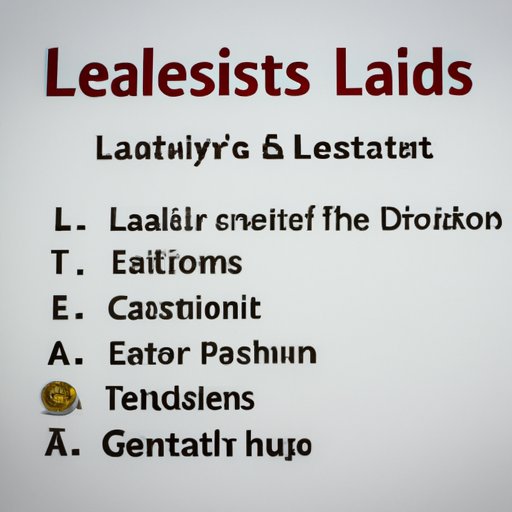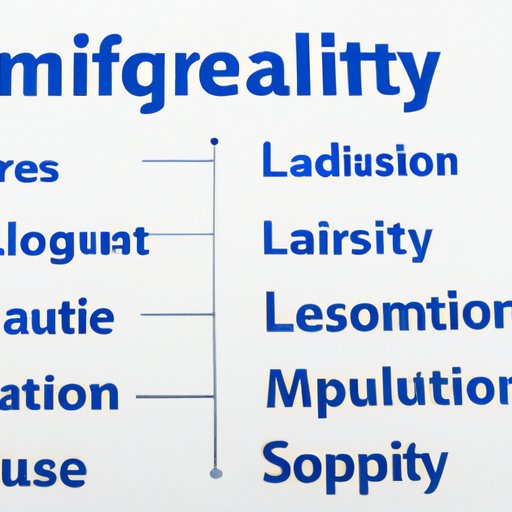Introduction
Leadership is an essential quality that can be found in many individuals, but it takes certain traits and characteristics to make someone a truly effective leader. A good leader has a clear vision and goals, strong communication skills, decision-making abilities, empathy, integrity, and self-confidence. Different leadership styles can be used to inspire and motivate others, and these techniques can have a positive impact on organizational performance.

Analyzing the Traits of Successful Leaders
Successful leaders have a variety of traits that help them to excel in their roles. Among the most important are:
Vision and Goals
Good leaders have a clear vision of where they want to take their organization and how they plan to get there. They are able to set ambitious yet achievable goals, and they have the drive and determination to reach them. As former United States President Franklin D. Roosevelt said, “The only limit to our realization of tomorrow will be our doubts of today.”
Communication Skills
Effective leaders understand the importance of communication, and they use it to keep everyone in the organization informed and on the same page. They know how to articulate their vision and goals in a way that is easy to understand, and they use both verbal and non-verbal communication to ensure that their message is heard loud and clear.
Decision-Making Abilities
Leaders must be able to make quick, informed decisions even in difficult or uncertain situations. Research has shown that good leaders are able to assess a situation accurately and weigh the pros and cons before making a decision. They also understand the importance of involving other stakeholders in decision-making process when necessary.
Empathy
Empathy is a key trait of successful leaders. It allows them to understand the needs and motivations of those around them and to connect with people on a deeper level. Studies have found that leaders who show empathy are more effective in motivating and inspiring their teams.
Integrity
Leaders must have a strong moral code and demonstrate honesty and fairness in all aspects of their work. They should lead by example and practice ethical behavior, as this helps to build trust among team members and inspire loyalty.

Exploring Different Styles of Leadership
Different leadership styles can be used to achieve different outcomes. Some of the most common styles include:
Autocratic
In this style of leadership, the leader makes all the decisions without consulting anyone else. This can be effective in some situations, such as during emergencies or when a decisive decision is needed quickly. However, it can also lead to resentment and lack of engagement among team members.
Democratic
In this style, the leader encourages input from team members and involves them in the decision-making process. This can help to foster collaboration and create a sense of ownership, but it can also lead to lengthy discussions and delays in decision-making.
Transformational
This style of leadership focuses on inspiring and motivating team members to achieve great things. The leader sets ambitious goals and provides support and guidance to help team members reach them. This style can be very effective in building morale and fostering a sense of achievement.
Laissez-Faire
In this style, the leader delegates tasks and gives team members freedom to make decisions. This approach can be beneficial if the team members are knowledgeable and experienced, but it can also lead to confusion and lack of direction.
Examining the Qualities of Effective Leaders
In addition to the traits discussed above, good leaders also need to possess certain qualities that will help them to be successful in their roles. These include:
Self-Confidence
Leaders must have confidence in their own abilities and decisions. They must also be able to project self-confidence in order to gain the respect of their team members.
Self-Awareness
Good leaders must be aware of their strengths and weaknesses and understand how these affect their leadership style. They must also be willing to adapt their approach as needed.
Adaptability
Leaders must be able to adjust their strategies and tactics in response to changing circumstances. This requires flexibility, creativity, and an open mind.
Creativity
Effective leaders are innovative and think outside of the box. They are able to come up with creative solutions to problems and see opportunities where others may not.

Investigating How Good Leaders Inspire and Motivate Others
One of the most important responsibilities of a leader is to inspire and motivate their team members. Good leaders do this by:
Setting an Example
Leaders must lead by example and demonstrate the behaviors that they expect from their team members. This includes showing commitment, dedication, and enthusiasm for the work.
Recognizing Achievements
It is important for leaders to recognize and celebrate the successes of their team members. This can be done through words of praise, awards, or other forms of recognition.
Acknowledging Weaknesses
Good leaders understand that everyone has weaknesses, and they work to identify and address these weaknesses in order to help their team members improve and grow.
Providing Support
Leaders must provide support and guidance to their team members when needed. This can include offering advice, providing resources, or simply lending an ear when someone needs to talk.
Understanding the Impact of Good Leadership on Organizations
Good leadership can have a positive impact on an organization. It can lead to improved morale, enhanced productivity, and increased profitability. For example, a study by the University of San Diego found that companies with strong leadership had significantly higher returns on equity than companies with weak leadership.
Comparing and Contrasting Leadership Techniques
Different leadership styles can be used to achieve different outcomes, and it is important to understand the pros and cons of each approach. For example, autocratic leadership can be effective in some situations, but it can lead to resentment and lack of engagement. On the other hand, democratic leadership can promote collaboration and ownership, but it can also lead to lengthy discussions and delays in decision-making. It is often beneficial to combine different techniques in order to get the best results.
Conclusion
This article has explored what makes a good leader, analyzing the traits and qualities that successful leaders possess, as well as examining different styles of leadership and their impact on organizations. Good leaders have a clear vision and goals, strong communication skills, decision-making abilities, empathy, integrity, and self-confidence. They must also be able to inspire and motivate their team members and have a positive impact on organizational performance. Different leadership styles can be used to achieve different outcomes, and it is often beneficial to combine different techniques in order to get the best results.
(Note: Is this article not meeting your expectations? Do you have knowledge or insights to share? Unlock new opportunities and expand your reach by joining our authors team. Click Registration to join us and share your expertise with our readers.)
